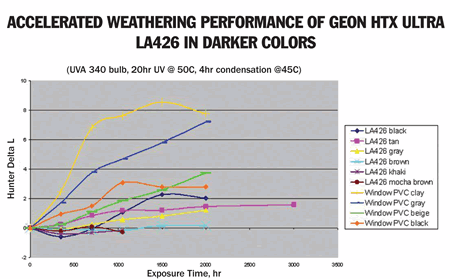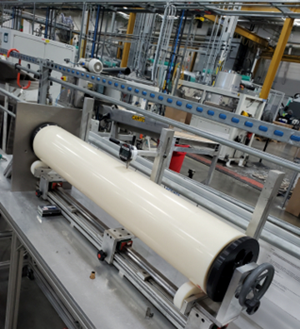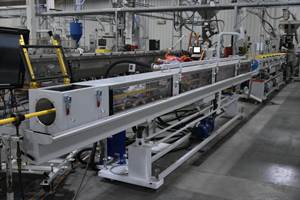New Resins and Modifiers for Extruded Profiles
Among new developments discussed at the Profiles 2007 conference in Charlotte, N.C., were high-melt-strength polyolefin elastomers for use as ingredients in TPO compounds that can compete with TPVs and flexible PVC.
Among new developments discussed at the Profiles 2007 conference in Charlotte, N.C., were high-melt-strength polyolefin elastomers for use as ingredients in TPO compounds that can compete with TPVs and flexible PVC. Organized by Applied Market Information LLC, the June conference also presented new PVC alloys that boast superior heat resistance and weatherability in dark-colored profiles. Another new product highlighted at the meeting was a compatibilizer based on new chemistry that reportedly outdoes previous products at improving the physical properties of mixed recycle streams containing mainly polyethylene.
New tougheners for TPOs
Three new grades of high-melt-strength (HMS) polyolefin elastomers (POEs) from Dow Specialty Plastics and Elastomers are recommended for use in TPOs for extruded profiles, thermoformable sheet, and blow molding. These POEs are made with Dow’s Insite metallocene catalyst to produce a high degree of branching in the reactor. The result is said to be soft materials with enhanced melt strength. When used in blends with HMS PP, fillers, and plasticizers, they can produce soft TPOs with excellent extrusion processability and rapid set-up, comparable to TPV and flexible PVC. They are said to require much lower extruder torque (power consumption) than conventional olefin elastomers or PPs. In addition, finished products reportedly have smoother surfaces and controlled gloss.
The first of these elastomers, Engage 7387 (0.87 g/cc density, <0.5 MI, and 88 Shore A hardness) was introduced three years ago but is now commercial. So far, it is attracting the most interest in low-gloss automotive soft sheeting and thermoforming applications, although it can be used in profiles.
Developmental ENR 7086.01 is a high-melt-strength ethylene-butene copolymer that boasts a high level of long-chain branching and a relatively broad MWD. It has been used alone and for modifying PP homopolymers and copolymers for blow molding, extrusion, and thermoforming. Potential applications include beverage tubing and blow molded bellows.
Developmental ENR 6386 is Dow’s new premier grade for profiles when paired with HMS-PP in a TPO compound. This is the most highly branched grade and shows excellent shear-thinning rheology, which reportedly enables very high extrusion speeds comparable to those for TPV or PVC. This modifier (0.875 g/cc, 0.5 MI, 75 Shore A) can be mixed with 20% to 40% HMS PP by batch or in-line compounding to achieve upper service temperatures between 80 C and 120 C (176 to 248 F). It reportedly can replace flexible PVC and TPVs in applications not needing compression-set performance.
High-heat, weatherable alloys
PolyOne Corp. unveiled a new line of PVC alloys claimed to offer exceptional heat resistance (HDT of 190 to 195 F at 264 psi) without warping or sagging, as well as superior weatherability for dark-colored profiles in all climates. Also cited are better flow and a lower specific gravity than competitive products, which leads to lower part weight. The new Geon HTX Ultra compounds are applicable for use as solid profiles or weatherable cap layers. They are aimed at windows, fences, decking, railings, siding, and other construction profiles.
Geon HTX Ultra products are also said to outperform conventional high-heat PVC and CPVC compounds, while being “process-friendly.” PolyOne presented results of accelerated and outdoor weather testing in which black, dark brown, and dark green profiles made with Geon HTX Ultra showed less color shift. Outdoor testing was conducted in Arizona, Florida, and Ohio. The last is noteworthy because it is representative of the northern industrial climate, which has proven to be extremely harsh and difficult for traditional PVC profiles to maintain their color properties.
Data in the accompanying chart demonstrate that in a number of different colors, the maximum color shift was approximately 3 delta L for Geon HTX Ultra, while conventional PVC window compounds showed changes as much as three times greater.
Recycle compatibilizer
A reportedly unique additive that compatibilizes PE-based recycle streams for use in plastic lumber and other products is said to be making headway in the market, owing to its improved effectiveness over traditional maleic anhydride (MAH) grafted polymers. DuPont’s Fusabond E EC-603D, which first arrived a year ago, is an anhydride-functional ethylene copolymer. Its role is to improve the interface between a non-polar polymer such as HDPE, LLDPE, or LDPE and a polar polymer such as EVOH and nylon. Because its functionality is built into the polymer backbone, rather than grafted on after polymerization, this copolymer has significantly higher anhydride levels, which provide more reactive binding sites, DuPont explains. As a result, this additive has a wider operating window for coupling with EVOH, moisture, lubricants, nylon, and fiberglass, which allows users to buy cheaper recycle vs. more costly “cleaner” reclaim.
Initial trials showed that with only 0.5% of this copolymer, notched Izod impact strength of wet blends is more than four times higher than with 1% of a workhorse grafted modifier. Recent trials have shown this degree of improvement in impact properties in several blends of 1.0 MI HDPE with 9% wet or dried EVOH. Some blends included 2% zinc stearate, 10% PP, or 11% nylon. Moreover, the copolymer’s ability to bind the polar contaminants into the polymer matrix reportedly reduces die build-up.
Related Content
Teel Straps on Yellow Belt to Cut Scrap on Big Cores
Investments in a lean, continuous process pay off for this Wisconsin processor.
Read MoreBelling Machine Forms 'Rieber' Socket in PVC-O Pipe
Italy’s SICA has developed an innovative Rieber belling process specific for PVC-O pipes. At the same operating pressure, these pipes require a wall thickness of about 35-40% less than those in conventional PVC pipe and allow the construction of water supply pipes up to 25 bar of operating pressure.
Read MoreTeel Adding Capacity, Bumping Pay for Hourly Workers
Teel growing to meet market demand, meaning increased employment opportunities for the area.
Read MorePut Some ‘Lean’ into Your Profile Extrusion Process
With everyone struggling to find talent, there are ways to reduce operator interaction with the process by applying some lean manufacturing principles.
Read MoreRead Next
How Polymer Melts in Single-Screw Extruders
Understanding how polymer melts in a single-screw extruder could help you optimize your screw design to eliminate defect-causing solid polymer fragments.
Read MoreWhy (and What) You Need to Dry
Other than polyolefins, almost every other polymer exhibits some level of polarity and therefore can absorb a certain amount of moisture from the atmosphere. Here’s a look at some of these materials, and what needs to be done to dry them.
Read More



















.png;maxWidth=300;quality=90)






